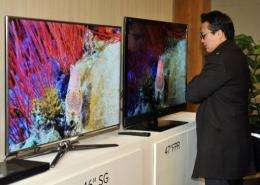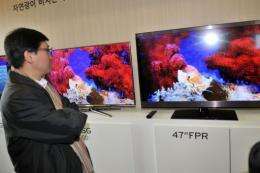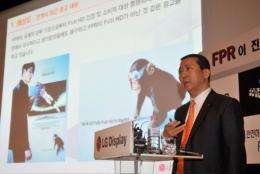Samsung and LG in rare public battle about 3-D TV

South Korea's electronics giants are engaged in rare public mudslinging about whose 3-D television technology is better, as they battle for a greater share of a potentially huge global market.
Samsung Electronics and LG Electronics, respectively the world's largest and second largest flat-screen TV makers, each claim their technology offers more vivid images and wider viewing angles.
The two firms, both driven by newly-appointed leaders, are striving to set the 3-D industry standard. Market researcher DisplaySearch forecasts that 3-D will account for 41 percent of all flat-screen shipments worldwide by 2014, compared to two percent last year.
LG champions a technology called film-patterned retarder (FPR), while Samsung uses so-called active shutter glass technology.
The two conglomerates rarely attack each other's products but a war of words began in January at the Las Vegas Consumer Electronics Show.
Exchanges heated up last month when LG reportedly described Samsung's 3-D technology as a generation behind.
The following day, a Samsung Electronics press release said the difference between its product and that of its competitor was "one of night and day".
On Tuesday Samsung again attempted to rubbish its rival.

Kim Hyeon-Seok, executive vice president of Samsung's visual display unit, described LG's claim that its 3-D TVs offer wider angles than Samsung's as "an attempt to deceive consumers".
"It is unacceptable that LG claims that FPR is better than active shutter glasses when the whole world says otherwise," Kim said.
Samsung has even published a print ad featuring a popular actor next to a small monkey, both wearing special glasses for 3-D viewing. The monkey's caption reads "Why is my 3-D TV not fully high-definition?"
Samsung denies the monkey symbolises LG.
Kwon Young-Soo, CEO of LG Display -- LG Electronics' flat panel unit -- urged Samsung Thursday to "stop the ads attacking another firm" and maintained his firm's technology is more advanced.

Kwon said LG's special glasses, required to watch 3-D TVs, are lighter, cheaper, transmit fewer electromagnetic waves and cause less blurred vision than Samsung's.
"I feel so sorry that the whole debate over facts has developed into a mudfight," Kwon told reporters. Japan's Sony Corp is considering adopting the Korean flat panel maker's new display technology for 3-D TVs, he said.
Yoon Boo-Geun, the head of Samsung Electronics' TV business, earlier Thursday called the controversy "unnecessary and exhausting", saying the smaller rival was "trying to break a rock with an egg".
Samsung Electronics was the world's top maker of 3-D TVs by shipments in the fourth quarter last year with a 37.2 percent stake, according to DisplaySearch.
Japan's Sony and Panasonic came second and third, followed by LG Electronics with 5.6 percent.
Both the South Korean giants are battling for market share under new leaders. LG Electronics in September elevated founding family member Koo Bon-Joon to CEO.
Jay Y. Lee, the only son of Samsung chairman Lee Kun-Hee, was promoted to president of Samsung Electronics last December.
Greg Roh, an analyst at HMC Investment Securities, called the feud "psychological warfare" partly aimed at boosting each company's reputation among consumers less willing this year to buy new TVs.
"Demand for new TVs this year is deemed low as many consumers already own new LCD and PDP (plasma) TVs... so the firms may need something to boost their standing among consumers even slightly," he told AFP.
"But this whole marketing fuss attacking each other looks very childish, unproductive and incomprehensible."
(c) 2011 AFP


















